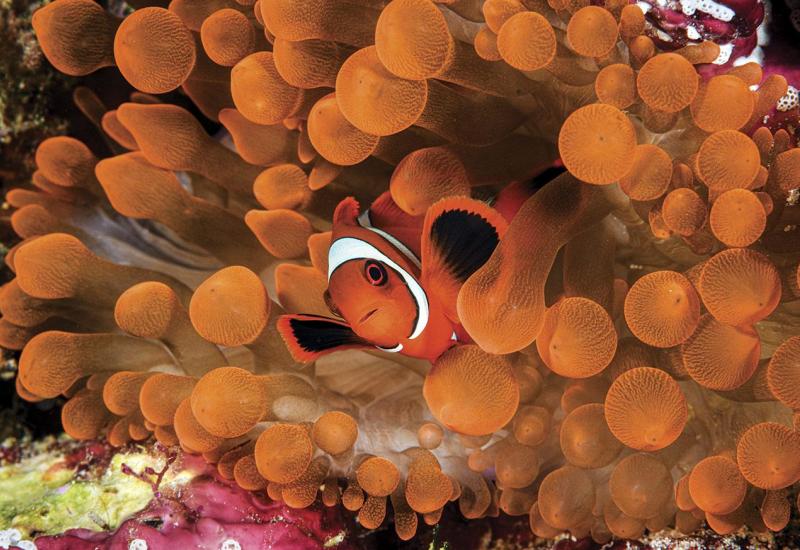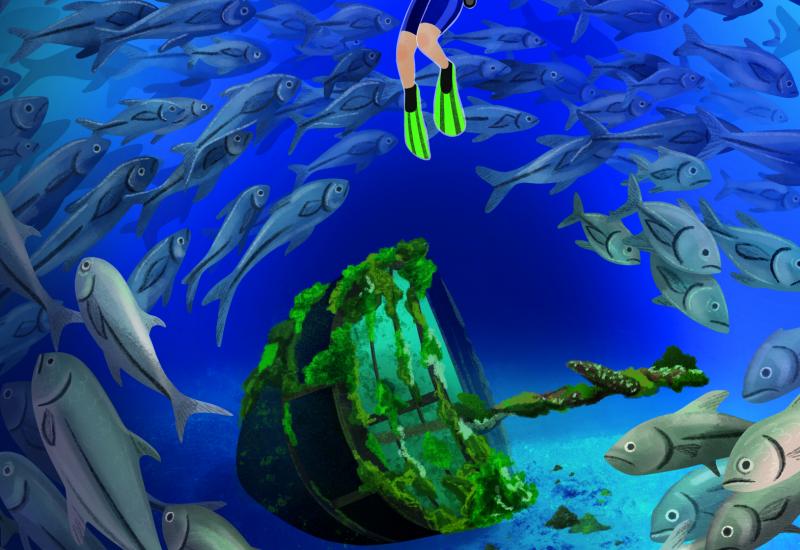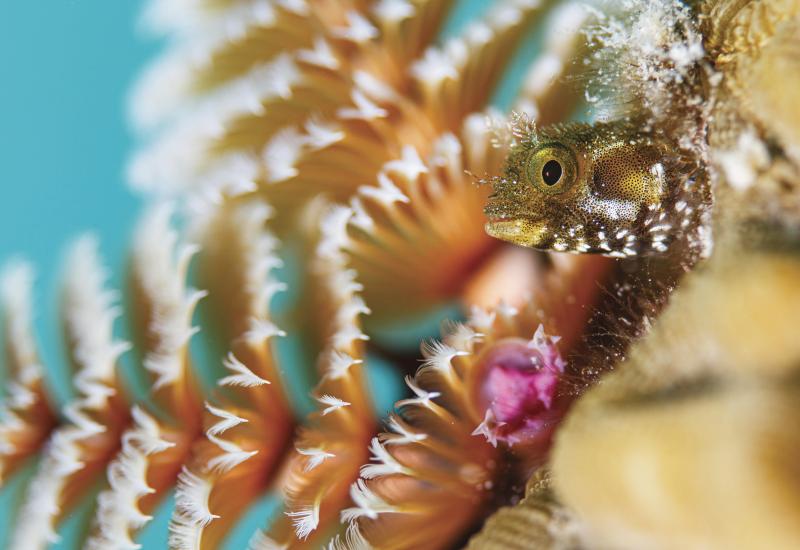Dream Duo: Critter-Spotting and Reef Diving in Indonesia
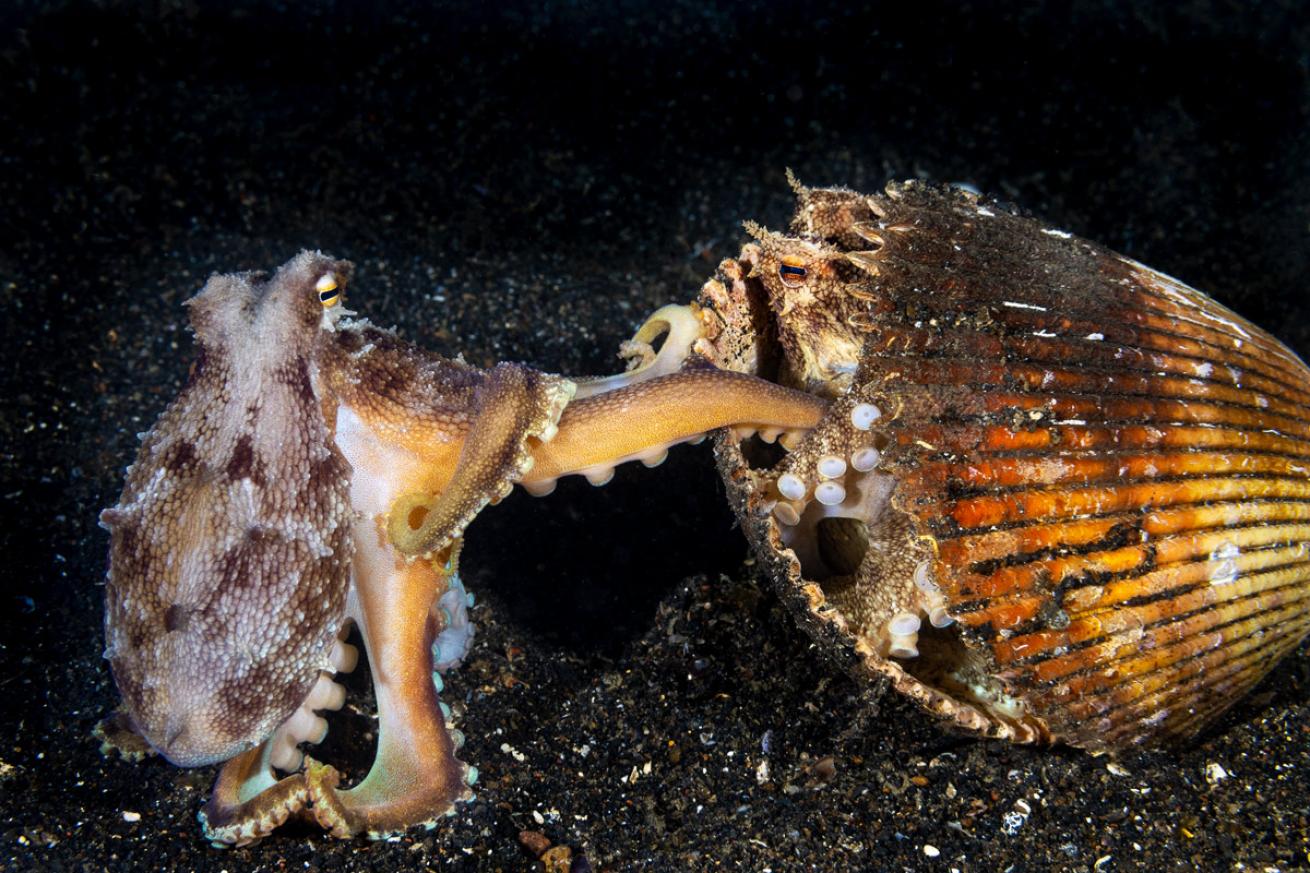
Andy Sallmon and Allison Vitsky SallmonTwo coconut octopuses mate in Lembeh Strait.
Despite days of vigorous debate, my husband and I were no closer to an agreement. Nearly every destination in the world was open for tourism again, I had accrued years’ worth of vacation time at work, and we were just plain desperate for an exciting dive trip. During the “before” (pre-pandemic) times, we’d maintained an orderly checklist of upcoming and wished-for travel destinations.
The list was long, but we worked our way through it in a systematic, logical fashion. Now our list was a disorganized jumble, marred by such an extended stretch of limited travel and heightened emotions that being methodical was impossible. I was ready to jam my finger down on the list at random and say, “There! That’s where we’re headed. Let’s pack and go!”
We wanted a spectacular destination, but one that we’d visited before, a place that offered the ease and comfort of familiarity. We finally managed to agree on Indonesia—with one of us deciding firmly on Lembeh and the other insisting on Raja Ampat. And that’s where we reached an impasse.
I watch the lanky brown- and cream-banded cephalopod scooting across the seafloor. Exhausted or not, I’m filled with gratitude that I’m able to travel to this amazing place again.
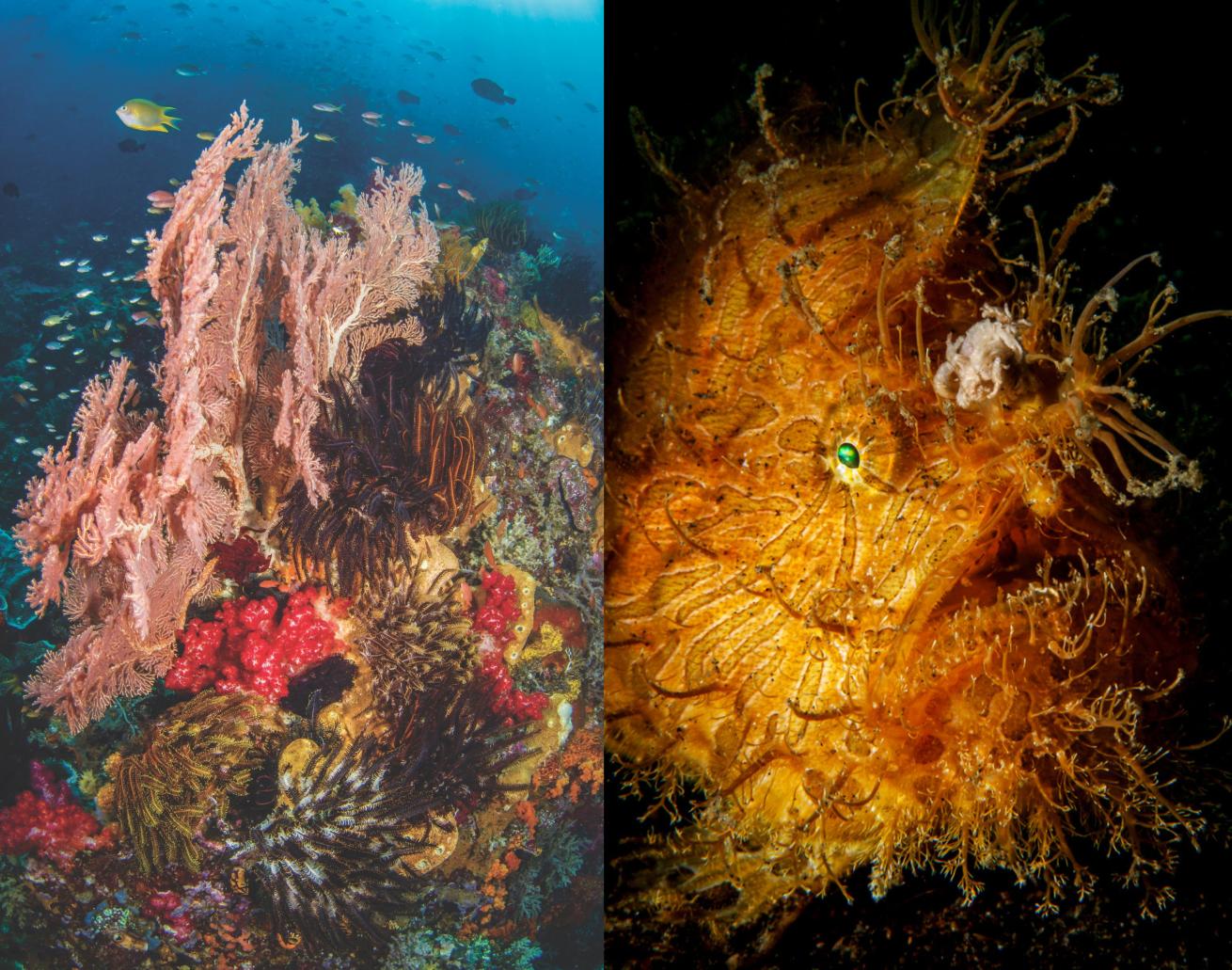
Andy Sallmon and Allison Vitsky SallmonFrom left: A lively reef in Raja Ampat’s Dampier Strait; a hairy frogfish patrols the Lembeh muck in search of its next meal.
Incredible critters, or stunning reefscapes? We were tired of bickering, and determining which of these two destinations was “best” would be futile. So we did what few normal people would do: We booked an expedition encompassing both destinations, two of the world’s inarguable best, one right after the other. After all, if the past few years had taught us anything, it was to enjoy life as much as possible every single day.
And if I returned from our long voyage with all my paid vacation time used? All the better.
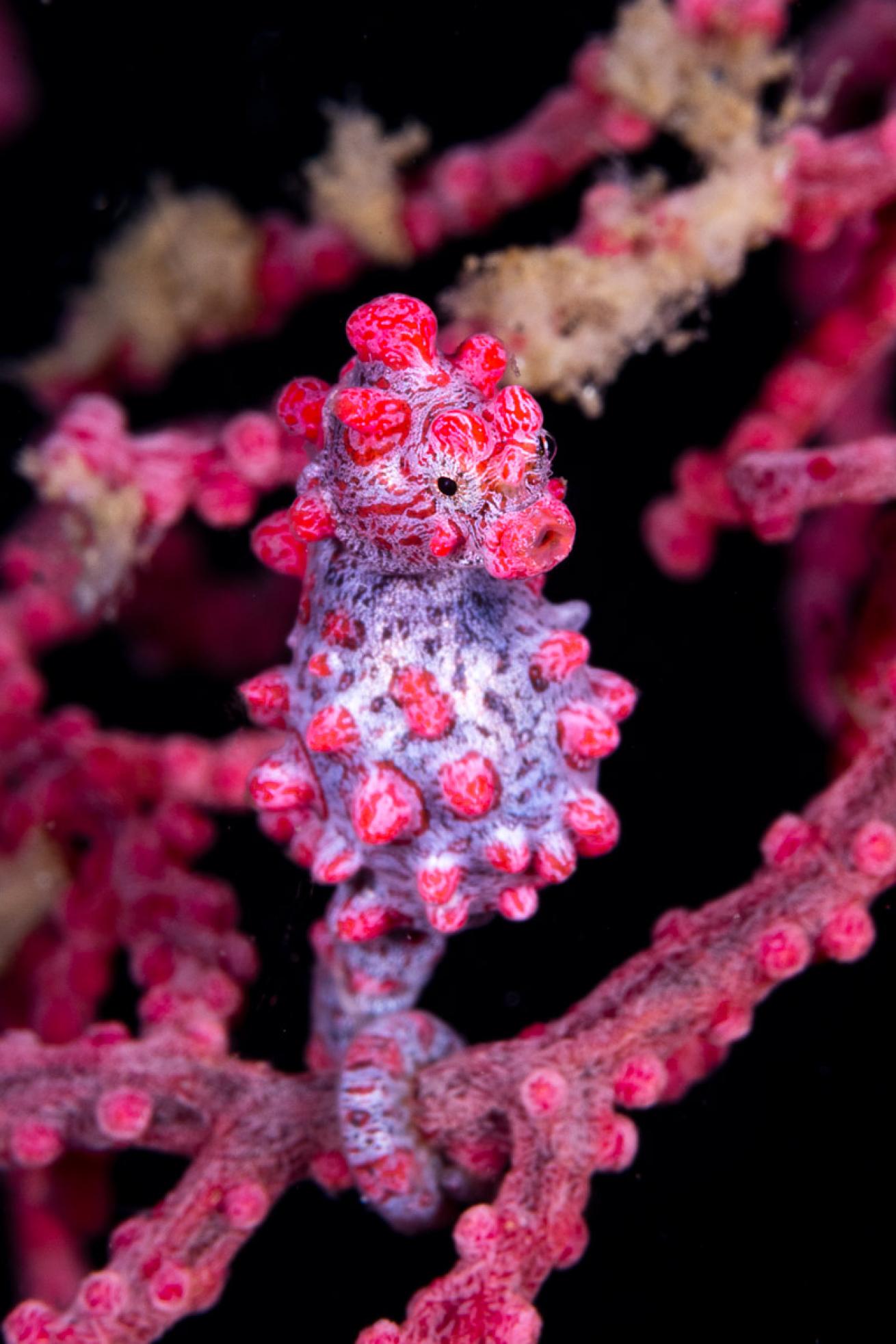
Andy Sallmon and Allison Vitsky SallmonA Bargibant’s pygmy seahorse at Nudi Falls.
Magical Muck
I’ve never been so happy to see sand. I’m hovering over the bottom at the black-sand site Hairball, grinning down at the silty muck, giddily thinking, I’m in Lembeh! followed by, I might be more than a little jet-lagged, when I hear my guide’s signal. He points. There’s a hairy frogfish moseying across the sand, stopping every so often to wave his lure around in the hopes of grabbing a quick snack. I might be blearyeyed, but I know a critter-list star when I see one.
I hustle over to grab a few photos, then I lower my camera and watch one of the strait’s A-list celebrities fishing for lunch. My guide signals again—waspfish. And again—demon stinger. Again—flamboyant cuttlefish. Then once more, and urgently—mimic octopus! I watch the lanky brown- and cream-banded cephalopod scooting across the seafloor. Exhausted or not, I’m filled with gratitude that I’m able to travel to this amazing place again.
Related Reading: Dive Travel Now: A Look at Panama, St. Lucia and Vancouver Island
After a day or two, my jet lag is a thing of the past, and I’m on a mission. Lembeh Strait, the narrow ocean channel between North Sulawesi and Lembeh Island, encompasses an astonishing number of incredible dive sites, and it’s best known for its mind-blowing variety of sometimes bizarre and often minuscule marine life. This 10-mile strip of water offers an assortment of habitats: black-sand sites abutting volcanic Sulawesi, rubbly white-sand sites adjacent to Lembeh Island, lush coral reefs and even a few shipwrecks—and I’m eager to see them all.
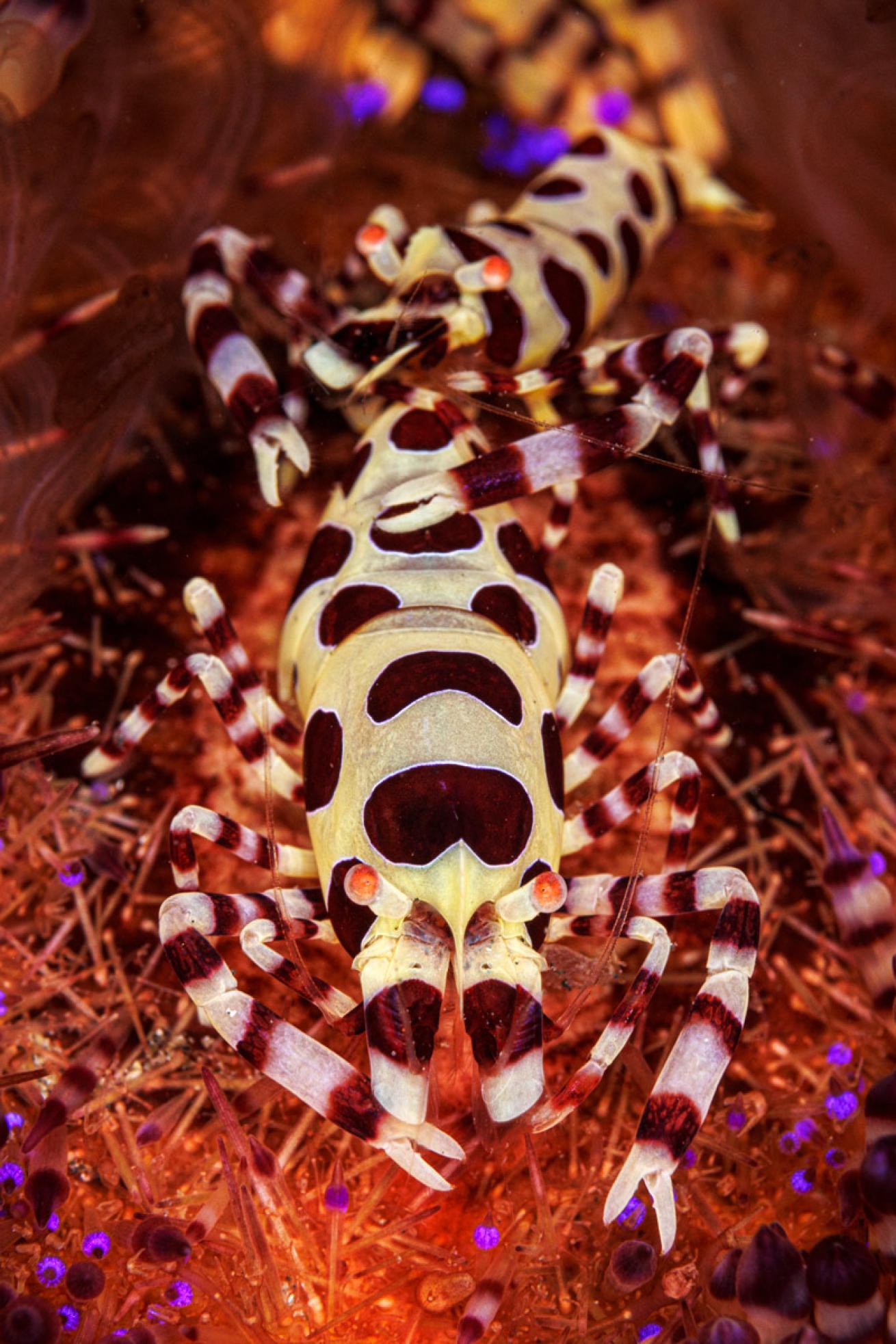
Andy Sallmon and Allison Vitsky SallmonA pair of Coleman shrimp.
Since a potentially life-changing three-dive day hardly requires us to spend 30 minutes of total commute time from where we are staying at Lembeh Resort, this isn’t a particular challenge. We spend one morning at the well-known dive spot Nudi Falls, ticking items off our critter list. Starting with a crinoid shrimp on the mooring, the sightings stack up quickly: candy crabs and soft coral cowries and gobies on the branches of soft coral growing straight up from the seafloor, pygmy seahorses on a large fan, and a banded Tozeuma shrimp on a fluffy branch of black coral, plus a peacock mantis shrimp and (surprise, surprise) about 10 species of nudibranchs.
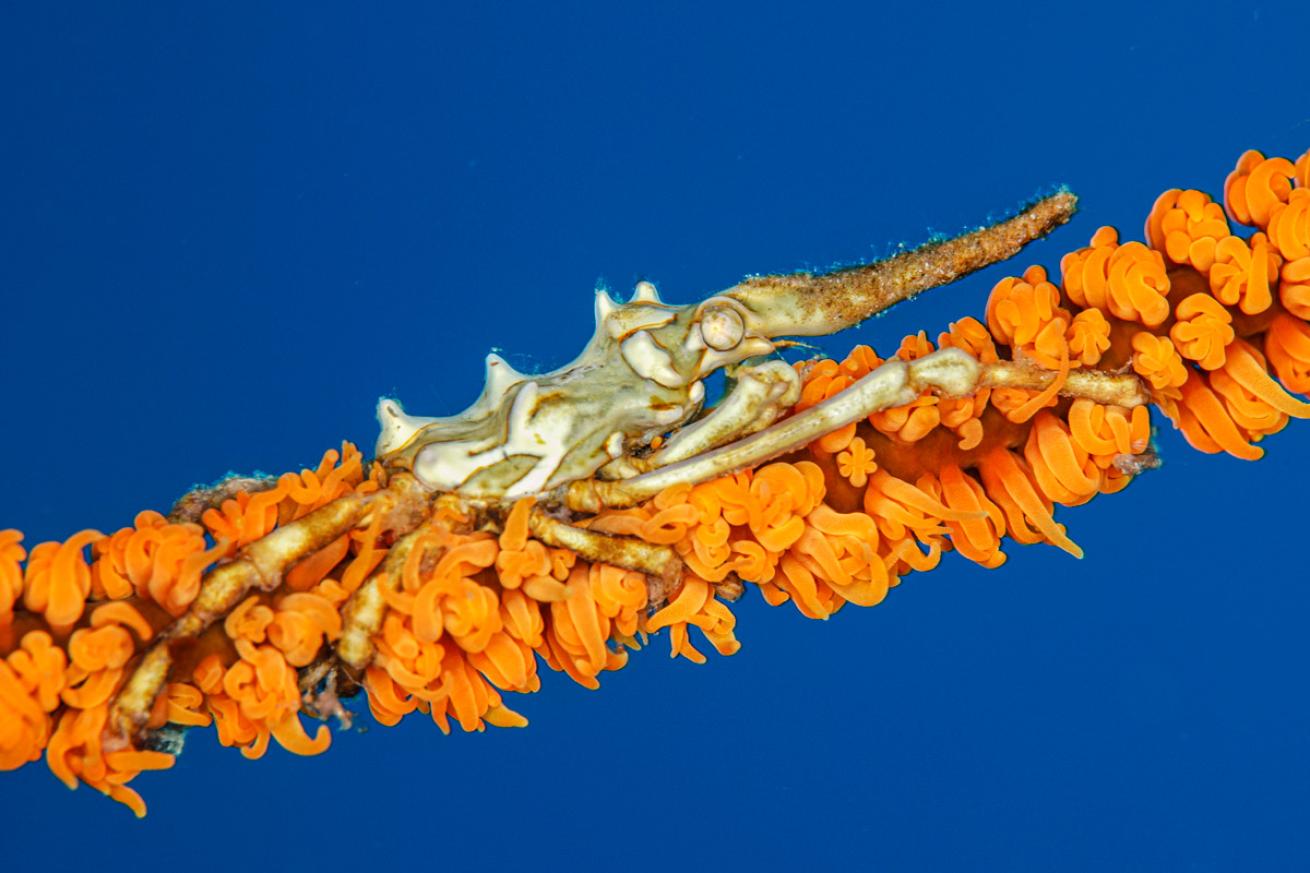
Andy Sallmon and Allison Vitsky SallmonA Xeno crab awaits a meal atop a whip coral.
We check off a few more “most-wanteds” midday at Serena Besar—a red paddle-flap scorpionfish, a blue-ringed octopus, harlequin shrimp—before we hit pay dirt in the afternoon at Critter Hunt, where there appears to be an official gathering of the craziest creatures Lembeh has on offer, including tiger shrimp, dragon shrimp and a Melibecolemani, aka ghost nudibranch. This weird-looking translucent nudibranch is rare enough that it wasn’t even on our critter list. It so closely resembles a jumbled pile of spaghetti that my guide has to point it out twice, and even then it takes a while before I can figure out which end is the front.
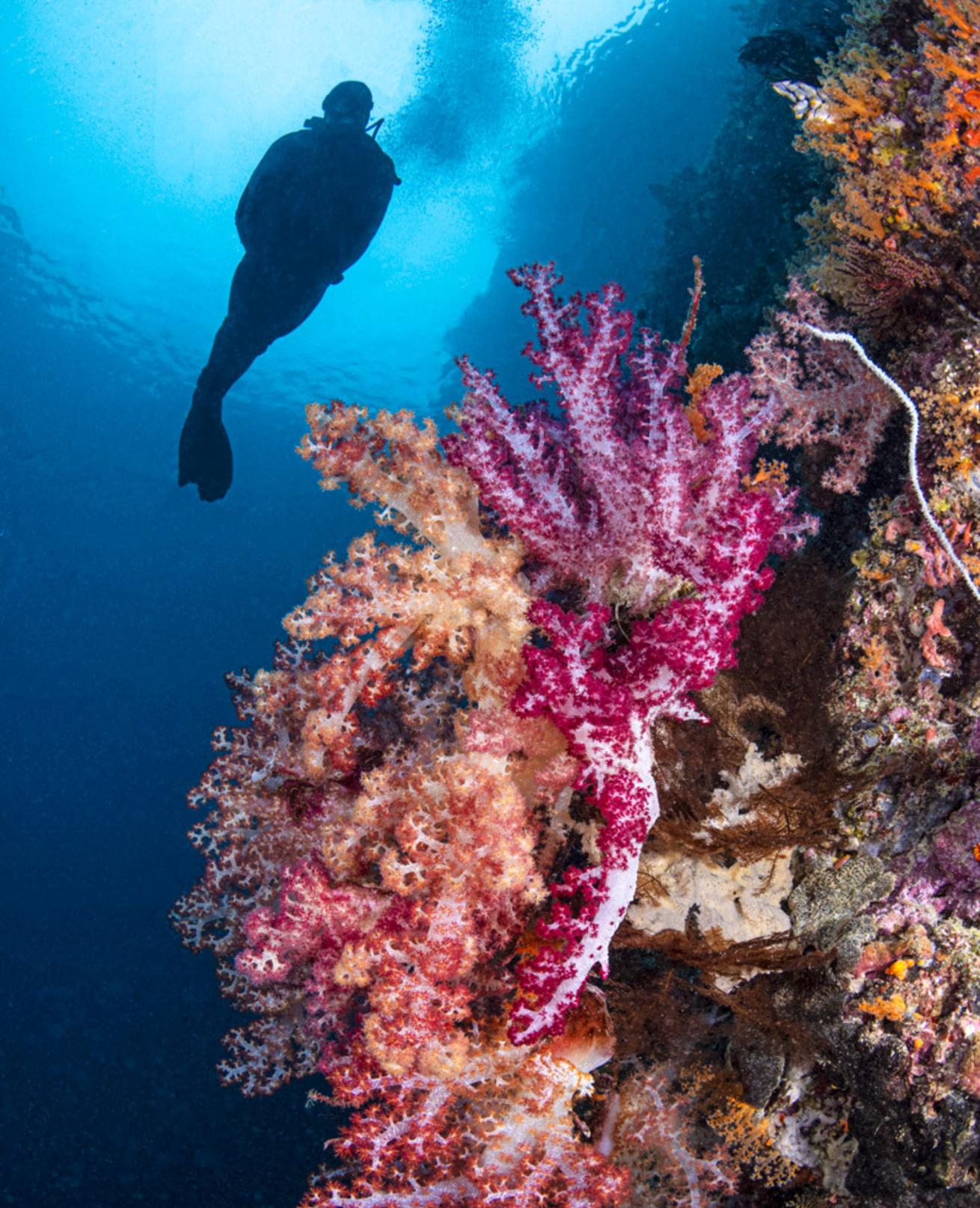
Andy Sallmon and Allison Vitsky SallmonA diver admires the lush soft corals at Gorgonian Passage.
One calm morning, we grab our wide-angle lenses and head toward the northern part of the strait, where a few fantastic sites abut Lembeh Island. Our guide recently saw a few giant frogfish at Angel’s Window, a reef with a soft-coral-encrusted swimthrough, and once we’re submerged, we busily begin searching for our target. We find two: a black one in an inconvenient face-down position, and a yellow one, posing on a sponge like a supermodel. We take turns photographing the prettily arranged frogfish, and while I’m waiting, I glance down at an orange whip coral.
A plump Xeno crab is sitting on it. I groan in frustration. It may be huge by Xeno crab standards, but it will still require a macro lens. I begin inspecting nearby whip corals and find four more crabs. Frustrating as it is, I know that even if I’m out of luck for today, we can just return with the appropriate gear tomorrow. It’s a good reminder: Always anticipate seeing unique small marine life in Lembeh.
Before we know it, we’re debating our final Lembeh dive site. We don’t hesitate to request Air Prang, a black-sand site where a few ridiculously lucky divers supposedly spotted a wonderpus carrying a clutch of eggs the day before. As soon as our boat stops, we splash in and begin combing the area. Forty-five minutes later, having found no wonderpus (with eggs or otherwise), we settle in to photograph some of the many coconut octopuses in the shallow water while the afternoon light fades.
As I watch a curious octopus peep out from between two clamshells, I notice movement on the nearby sand—another coconut octopus is approaching, and fast. It’s not a big creature, but it’s undoubtedly very determined. I begin to panic—am I going to witness an epic battle? The brute stomping our way doesn’t seem deterred by the presence of a giant bubbleblower holding a large camera, so it seems unlikely that the shy charmer in the clamshells has a chance against him.
He approaches assertively and extends an arm over the top of the shells while I prepare to witness the worst. But seconds later, it dawns on me what I’m seeing: The arm is a hectocotylus, a specialized arm used for reproduction. I watch (don’t judge me) until the act is over, and then I surface, elated. I may not have seen a wonderpus with eggs this afternoon, and that might have been my last dive in Lembeh, but while tomorrow’s rumor—“a few ridiculously lucky divers got to watch coconut octopus sex”—is circulating, I’ll still be buzzing with excitement over this dive. Oh, and I’ll also be on my way to Raja Ampat to dive some of the planet’s most pristine reefs.
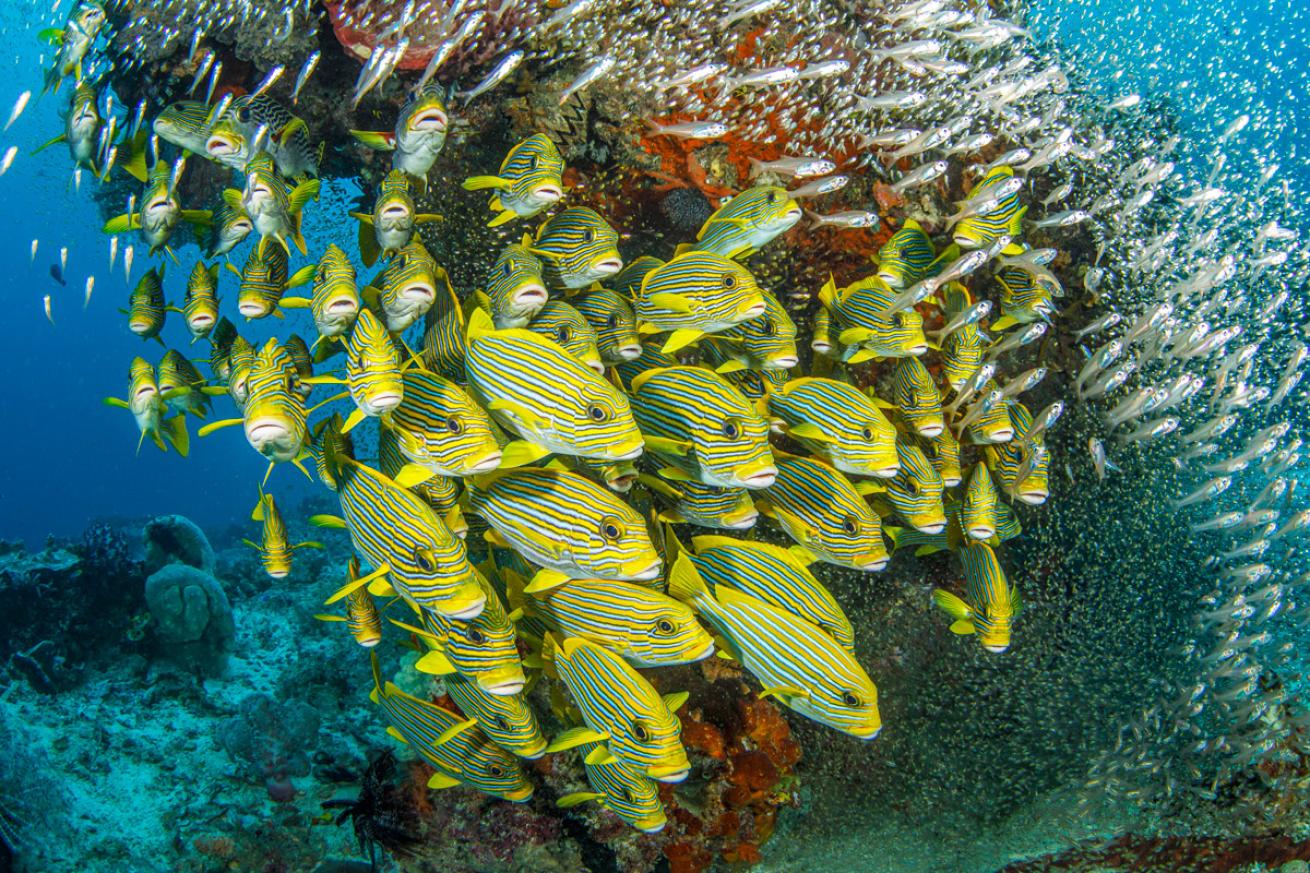
Andy Sallmon and Allison Vitsky SallmonA school of sweetlips is encompassed by a swirl of glassfish at Raja Ampat’s Otdima Reef.
Remarkable Reefs
So. Many. Fish. That’s not surprising, since the Bird’s Head Seascape, which encompasses Raja Ampat (Indonesian for “Four Kings”), as well as adjacent Cenderawasih Bay, Kaimana Regency, and Triton Bay, features a network of 26 marine protected areas. But there’s a big difference between simply diving in a protected area…and this.
This, to be precise, is Otdima Reef, where I’m facing a huge school of yellow-ribbon sweetlips encircled by an equally large school of glassfish. The sweetlips sway into the current, and every so often the glassfish move in a sparkling, circumferential swoosh. I’d like to stay here for the whole dive, but soon enough, it’s time to yield this spectacle to other photographers in our group. We reluctantly make our way down the elongated, ridgelike pinnacle, stopping to admire bommies obscured by clouds of golden sweepers and to photograph a wobbegong curled atop an outcropping of coral.
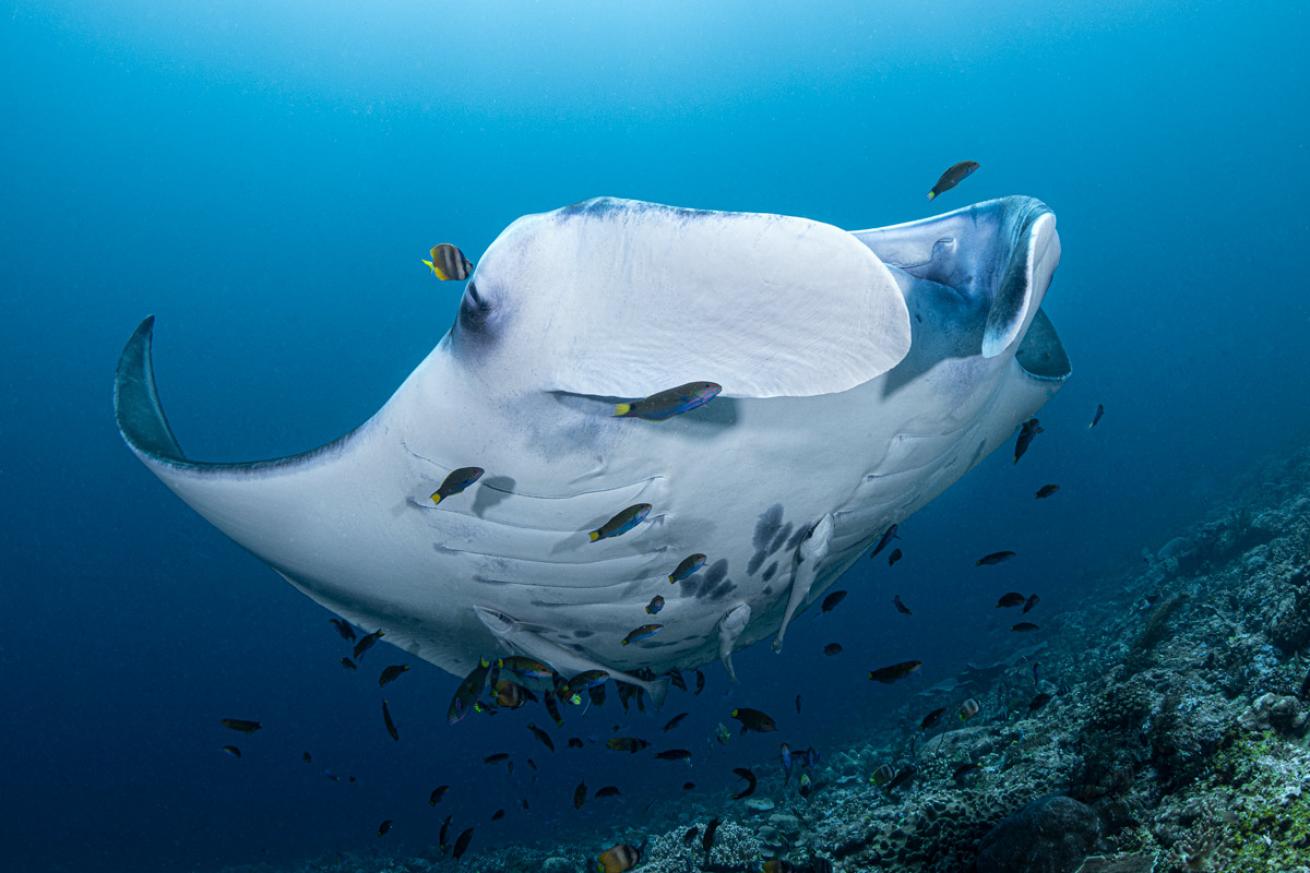
Andy Sallmon and Allison Vitsky SallmonThe dive site Manta Ridge lives up to its name.
We, along with our fellow passengers aboard the Samambaia liveaboard, are spending a few days exploring the Dampier Strait area before making our way south to Misool. Already, I am blown away. It’s not just the beauty of the coral that showcases the health of the marine life here; it’s the sharks (which we encounter at a distance on nearly every dive) and also—OK, especially—the rays.
This is particularly evident at Manta Ridge, where I count at least eight mantas feeding in the current next to the ridge itself, a shallow, pristine hard coral reef dotted with cleaning stations. The current is so fierce that it’s all I can do not to get pulled over the ridge at first. But it slows enough to allow me to hoist my camera into position when the mantas conclude their meal and approach us. They hover over our heads again and again, taking turns getting a post-lunch tidying.
Related Reading: The Longest Dive Trip Yet
One afternoon, we’re offered a chance to visit the mangroves near the island of Waigeo, and the group unanimously agrees we’re in the mood for a relaxed dive before we head south. Though the seafloor often resembles the fine muck we’ve just experienced in Lembeh and requires care not to destroy the visibility, the underwater ecosystem is otherworldly, with the tree roots and sun rays penetrating the water, and odd-looking denizens such as shrimpfish, archerfish and cardinalfish weaving past.
I swim slowly through the trees, stopping to photograph a lovely branch of soft coral, and finish my dive on a peaceful coral ridge where anemones (their bleached tentacles being the only indication I’ve seen that climate change has affected this area) lie inches from the surface. I savor the still water, knowing that this may be our last mellow dive.
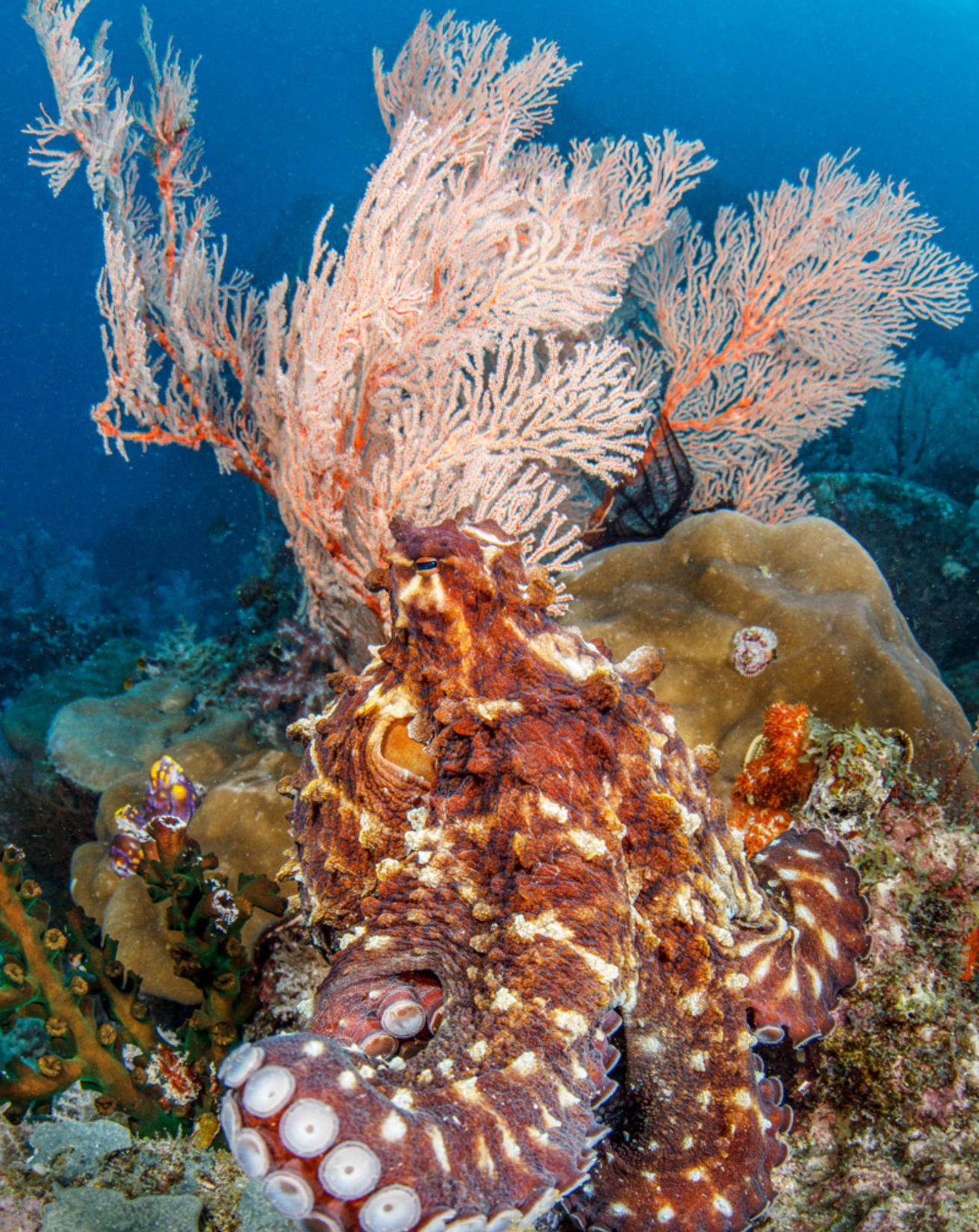
Andy Sallmon and Allison Vitsky SallmonAn octopus hunts in the open on the reef at Nudi Rock.
I’m thankful for that respite the next morning, when I’m being shuttled by a ripping current through Gorgonian Passage, past a technicolor blur of a wall that’s so covered with sea fans and soft corals that I suspect I’d have difficulty framing a photograph even if I could pause long enough to take one. I clip off my camera and enjoy the glorious ride, leaving a few swirling schools of silversides in the dust. Much as I enjoyed the speedy transit, I’m relieved when the current at famous Boo Windows is slightly tamer—still flowing, but manageable. We’re able to photograph the fans adjacent to the namesake swimthroughs, and easily make our way down the ridge that connects the two adjacent islands that mark the site. There’s no need to descend very deep here. Every jaw-dropping inch is layered with multihued soft coral and fans, nearly all the way to the surface. The same can be said for nearby Nudi Rock, where I never make it below 35 feet, although I become so distracted by an unafraid octopus that I nearly forget about the soft coral altogether.
When we back-roll into the water at Four Kings, a site composed of four spectacular pinnacles, I feel a brief twinge of melancholy. Our voyage is coming to an end, and I’ve handily used nearly all my paid vacation time so it will be a long while before we return. Once I’m below the surface, however, my sadness disappears. Each of the narrow pinnacles is covered with anemones, coral and gorgonians, and the water is thick with fusiliers and baitfish. We make our way around the spires, savoring the view.
I pause to photograph a cluster of pink, yellow and orange soft corals, then glance over my shoulder at my husband, who is shooting a fat scorpionfish under a burst of fish. He looks back at me with a huge grin. I know exactly what he’s thinking. No debate or bickering necessary: This trip was absolutely worth the wait.
There’s no need to descend very deep here. Every jaw-dropping inch is layered with multihued soft coral and fans, nearly all the way to the surface.
NEED TO KNOW
Lembeh Strait (North Sulawesi Province)
When to Go
Lembeh Strait offers incredible and protected diving year-round.
Dive Conditions
The dry season runs from June through September, with cooler water (75 to 79 degrees) and good visibility. The rainy season spans from November through April and is accompanied by higher water temps (79 to 84 degrees) but lower visibility. On average, visibility is approximately 30 feet.
Operator
Lembeh Resort (lembehresort.com)
Travel Tips
The closest airport to Lembeh Strait is in Manado, about a 45-minute drive from most resorts. Arranging your flight to Manado as part of a single international itinerary (rather than flying to an Indonesian destination, such as Bali, and then taking a domestic flight to Manado) may help you optimize your baggage allowance. For instance, single international itineraries from North America can be purchased readily through Singapore Airlines, since its subsidiary airline Scoot travels to Manado.
Dive Tips
Many sites in the strait are lined by fine black sand and require diligent attention to buoyancy—an errant fin kick can ruin visibility. Before you travel, brush up on muck diving techniques, and consider bringing a muck stick to assist with stabilization—your fellow divers will thank you. Although Lembeh Strait is best known for incredible macro creatures, don’t forget to pack your wide-angle lens! There are lovely reefs at the north end of the strait and on the east side of Lembeh Island.
Raja Ampat (West Papua Province)
When to Go
Traditional liveaboard itineraries encompassing the Dampier Strait and Misool areas are best pursued between October and March (many liveaboards move to other locations from May to September to avoid the winds and rough seas of the south west monsoon season). The northern portions of the Raja Ampat archipelago offer good diving year-round.
Dive Conditions
Water temperatures average around 83 degrees, and visibility ranges from 30 to 100-plus feet, depending on tides, rain runoff, plankton blooms and winddriven upwellings.
Operator
Samambaia Liveaboard (samambaia-liveaboard.com)
Travel Tips
Most classic Raja Ampat liveaboard itineraries depart out of Sorong, which is easily accessed via Jakarta. While booking your travel, an overnight stopover is highly recommended to allow for any travel mishaps and to begin adjusting to the time difference.
Dive Tips
The lush reefs and copious fish life here depend on current, so divers should be experienced and comfortable diving in strong and changing flow. Safety and diving conservatism are paramount in Raja Ampat: The nearest hyperbaric chambers are in Manado and Bali, and both require private air evacuation.

